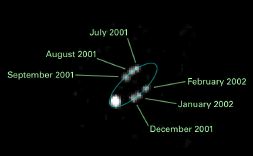

|
Документ взят из кэша поисковой машины. Адрес
оригинального документа
: http://www.stsci.edu/~inr/thisweek1/thisweek114.html
Дата изменения: Fri Aug 24 18:44:05 2007 Дата индексирования: Tue Oct 2 14:02:45 2012 Кодировка: Поисковые слова: п п п п п п п п п |


| Program Number | Principal Investigator | Program Title | Links |
| 10496 | Saul Perlmutter, Lawrence Berkeley National Laboratory | Decelerating and Dustfree: Efficient Dark Energy Studies with Supernovae and Clusters | Abstract |
| 10505 | Carme Gallart, Instituto de Astrofisica de Canarias | The Onset of Star Formation in the Universe: Constraints from Nearby Isolated Dwarf Galaxies | Abstract |
| 10512 | William Merline, Southwest Research Institute | Search for Binaries Among Faint Jupiter Trojan Asteroids | Abstract |
| 10514 | Keith Noll, Space Telescope Science Institute | Kuiper Belt Binaries: Probes of Early Solar System Evolution | Abstract |
| 10523 | Roelof de Jong, Space Telescope Science Institute | The Halo Shape and Metallicity of Massive Spiral Galaxies | Abstract |
| 10524 | Francesco Ferraro, Universita di Bologna | Blue Stragglers: a key stellar population to probe internal cluster dynamics | Abstract |
| 10527 | Dean Hines, Space Science Institute | Imaging Scattered Light from Debris Disks Discovered by the Spitzer Space Telescope Around 20 Sun-like Stars | Abstract |
| 10536 | Raghvendra Sahai, Jet Propulsion Laboratory | What Are Stalled Preplanetary Nebulae? An ACS SNAPshot Survey | Abstract |
| 10545 | Michael Brown, California Institute of Technology | Icy planetoids of the outer solar system | Abstract |
| 10549 | Robert Kirshner, Harvard University | SAINTS - Supernova 1987A INTensive Survey | Abstract |
| 10554 | Ray Sharples, University of Durham | Globular Cluster Systems of Elliptical Galaxies in Low Density Environments | Abstract |
| 10568 | Oleg Kargaltsev, The Pennsylvania State University | Ultraviolet spectrum of the binary millisecond pulsar J0437-4715 | Abstract |
| 10573 | Mario Mateo, University of Michigan | Globular Clusters in the Direction of the Inner Galaxy | Abstract |
| 10576 | Gabriel Prochter, University of California - Santa Cruz | An ACS Imaging Survey of the Galaxies Hosting Strong Mg II Absorption | Abstract |
| 10587 | Adam Bolton, Smithsonian Institution Astrophysical Observatory | Measuring the Mass Dependence of Early-Type Galaxy Structure | Abstract |
| 10592 | Aaron Evans, State University of New York at Stony Brook | An ACS Survey of a Complete Sample of Luminous Infrared Galaxies in the Local Universe | Abstract |
| 10602 | Jesus Maiz-Apellaniz, Space Telescope Science Institute - ESA | Complete Multiplicity Survey of Galactic O2/O3/O3.5 Stars with ACS | Abstract |
| 10626 | Yeong-Shang Loh, University of Colorado at Boulder | A Snapshot Survey of Brightest Cluster Galaxies and Strong Lensing to z = 0.9 | Abstract |
| 10782 | Imke de Pater, University of California - Berkeley | Quit winking: Jupiter opens its other eye | Abstract |
GO 10496: Decelerating and Dustfree: Efficient Dark Energy Studies with Supernovae and Clusters
GO 10514: Kuiper Belt Binaries: Probes of Early Solar System Evolution
 A composite of HST images of the Kuiper Belt binary, WW31
A composite of HST images of the Kuiper Belt binary, WW31
|
The Kuiper Belt consists of icy planetoids that orbit the Sun within a broad band stretching from Neptune's orbit (~30 AU) to distance sof ~50 AU from the Sun (see David Jewitt's Kuiper Belt page for details). Over 500 KBOs are currently known out of a population of perhaps 70,000 objects with diameters exceeding 100 km. Approximately 2% of the known KBOs are binary (including Pluto, one of the largest known KBOs, regardless of whether one considers it a planet or not). This is a surprisingly high fraction, given the difficulties involved in forming such systems and the relative ease with which they can be disrupted. It remains unclear whether these systems formed from single KBOs (through collisions or 3-body interactions) as the Kuiper Belt and the Solar System have evolved, or whether they represent the final tail of an initial (much larger) population of primordial binaries. This proposal aims to use ACS/HRC images of known KBOs toidentify new binary systems. |
GO 10573: Globular Clusters in the Direction of the Inner Galaxy
GO 10626: A Snapshot Survey of Brightest Cluster Galaxies and Strong Lensing to z = 0.9